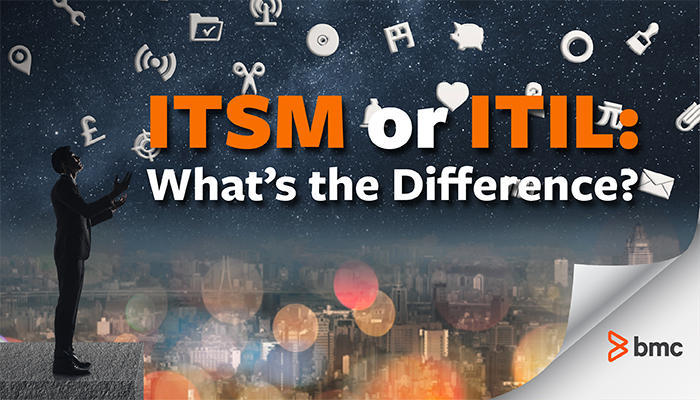Unsure whether you need ITSM or ITIL®? Trick question! When it comes to IT management, it isn’t one or the either. Here’s the difference:
- IT service management (ITSM) is what you do to manage the services you deliver to your customers, even if you don’t use that term.
- ITIL is a best practice framework for ITSM, and adopting some ITIL ideas can help you work more effectively.
Here’s what you need to know about ITSM and ITIL, and how an intentional approach to both will contribute to the success of your IT organization.
Download Now: ITIL 4 Best Practice e-Books
These all-new for 2020 ITIL e-books highlight important elements of ITIL 4 best practices. Quickly understand key changes and actionable concepts, written by ITIL 4 contributors.
Understanding ITSM & ITIL
Before we go any further, let’s take a quick peek at ITSM and ITIL, and the differences will become apparent.
IT Service Management (ITSM)
ITSM refers to the way you manage the information systems that deliver value to your customers. It is a generic term: you don’t have to choose a methodology of ITSM, though you can. Instead, if you’re running IT systems, you’re inherently performing ITSM.
As a catch-all term, ITSM encompasses all activities (including policies, processes, and procedures) that an enterprise performs in order to design, plan, deliver, operate, maintain, and control IT services. Examples of IT service management include activities like:
- Planning and managing systems changes to prevent business disruption or downtime
- Fixing IT issues offensively (before they break) or defensively (when they go wrong)
- Managing an IT budget so you can pay the bills or buy things when it’s time
Originally, ITSM as a term often referred to the way we manage technology, but more recently it has become a shorthand for how to deliver valuable services to customers. (For example, a sample of customer-focused ITSM topics include:
- Using automation to improve your service desk
- Creating processes for effective change management
Either way, your hardware and software and your IT services all require management—that’s ITSM.
ITIL
As you may imagine, the management of IT can take many shapes and forms—some more successful than others. Of the dozens of ITSM frameworks, the world’s most common is ITIL.
Historically, ITIL was the shortened form for IT Infrastructure Library, but the acronym has outgrown the term in the three decades since it was coined. Today, ITIL is a registered trademark of AXELOS, which owns a range of best practice solutions and corresponding publications and exams. ITIL has been adopted by many organizations, and there are millions of certified ITIL practitioners worldwide.
The goals of ITIL include promoting efficiencies and organizing effectively, so that businesses aren’t hampered by their IT goals but are instead propelled forward by strong, intentional IT management. ITIL aims to stay current and its latest iteration, ITIL 4, just premiered in April 2019. Its core components include the service value system and the four dimensions model.
The service value system components of ITIL include:
- The service value chain
- The practices
- The guiding principles
- Governance
- Continual improvement
To put in place the service value system, ITIL focuses on four dimensions:
- Organizations and people
- Information and technology
- Partners and suppliers
- Value streams and processes
(Learn more about all the ITIL phases and steps in our ITIL v3 Guide and our ITIL 4 Guide.)
Benefits of deploying ITIL
It is likely that some—probably many—of the ITIL best practices would benefit your organization. Companies that adopt ITIL often report that the framework helps:
- Align IT to their business, providing services that better meet the needs of their customers.
- Increase the quality of the IT services they deliver by understanding the required levels of availability, security, capacity, and continuity, and then planning solutions that are able to deliver these.
- Decrease the cost of delivering IT by reducing wasted effort
- Focus on getting things right the first time
- Promote continual improvement
You don’t have to adopt ITIL to manage your IT services effectively and efficiently, but it will certainly help. Some organizations simply create their own set of processes for running IT, and this can work. But it’s hard to develop something original that matches the years of experience that have gone into the development of the ITIL best practice framework that has now been adopted by many thousands of organizations.
Of course, as with any work efficiency framework, not everyone loves it. Critics of ITIL cite outdated practices and stale ideas that aren’t living up to the fast pace that innovation requires today. Other criticism includes its boring approach—particularly in training and certification settings—that make it difficult to learn, let alone adopt. Luckily, industry experts widely agree that ITIL 4 is a vast improvement over ITIL v3, putting to bed some of these old concerns.
Convergence tools from BMC, Atlassian, and Asana, among others, can be useful to ITIL but also may not require a specific ITIL framework to offer some of the same efficiency benefits.
Still, the benefits likely lie in how you put ITIL to work for your organization.
Putting ITIL to work: Adopt & adapt
As with any new practice or framework, there is always a caveat: for ITIL to be successful, your organization must decide which aspects to adopt and adapt and which factors may be less important.
The surest way to failure is to deliver a strict set of processes without building understanding on what you’re seeking or creating a culture that embraces these values. Time and time again, companies deploy ITIL practices without doing this work. You can guess what happens next: employees ignore the processes, blaming the system itself, and it’s only a matter of time before the company abandons the ITIL framework, reverting to what was “working” before. (This time with a more positive spin on their ITSM.)
Instead, any approach to ITIL should follow the advice of “adopt and adapt”:
- Adopt only the parts that you need
- Adapt the ideas to fit your environment
IT organizations that make use of ITIL decide for themselves which aspects to adopt. Many IT organizations choose to adopt only the operational processes, such as incident management and change management. On their own, these do provide some value, of course, but they are only a small part of the whole ITIL framework.
However, the lifecycle approach to ITIL may deliver the best value. This covers everything from your overall IT strategy through the design, transition, and operation of services; and it incorporates continual improvement into everything you do.
When your organization has made the decision to adopt a best practice framework, a smart strategy is to understand which approach will be a good fit for your organizational culture and to incorporate it into your own management system in a sympathetic way.
Is ITIL the only option? Additional ITSM frameworks
When it comes to ITSM, ITIL is not the only framework that can be effective. While it is the most widely used and understood around the world, some of the most successful companies use a variety of frameworks and best practices alongside ITIL. This can be very effective as each approach brings something different to the mix.
Here are some other common ITSM frameworks:
- COBIT is a very good framework for governance, audit, and compliance. It is much stronger than ITIL in these areas, and the two work very well together.
- Together, Agile and DevOps help to ensure the IT organization quickly delivers new business functionality. They often conflict with ITIL because of cultural differences between the people who adopt them, but they can fit together well if the organization understands the value each provides.
- Lean can be used to drive continual improvement and elimination of wasted effort. It is a great fit with ITIL continual improvement.
If you run IT services, you owe it to your customers to adopt ideas that will make you effective, efficient, and agile.
Additional resources
- BMC Service Management Blog
- ITIL 4 Guide
- Is ITSM Still Relevant in the Digital Age?
- The State of ITSM in 2021
- Who Uses ITIL?







